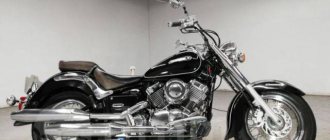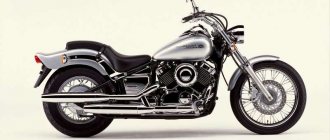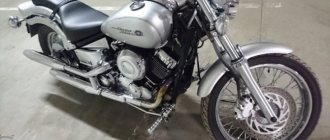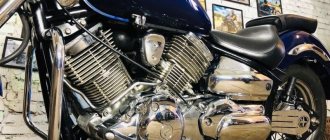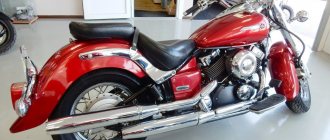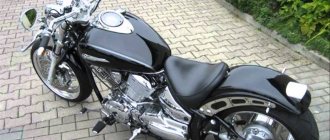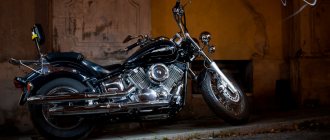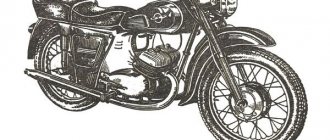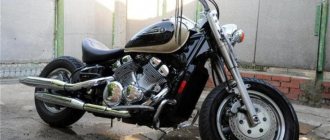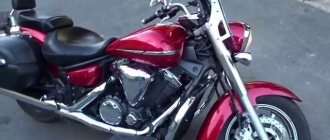- motorcycle model, Yamaha brand,
The Yamaha XVS400 Drag Star cruiser model appeared in 1996 as a successor to the Yamaha Virago 400, differing from it mainly in the new duplex frame (instead of the spinal one) and engine settings, which began to produce less power, but with a shifted torque characteristic to the zone low and medium speeds (operating speeds decreased by 1000 rpm). As a result, the engine began to produce up to 33 hp. power and 32 Nm of torque, with maximum performance starting from 6000 rpm.
The model is built on the basis of the older export version of the Yamaha XVS650 Drag Star / V-Star, differing from it in engine capacity and restyling. In addition, the Yamaha Drag Star 400 was aimed only at the domestic Japanese market.
In 1998, in addition to the regular version of the Drag Star 400, the classic version was introduced - the Yamaha Drag Star 400 Classic. It had a different handlebar, saddle, fenders, headlight, ergonomics and front wheel size. There were no technical differences.
In 2000, the model received a new version of the engine, which in terms of technical characteristics was no different from the previous one, but complied with new environmental standards. The dashboard has also been restyled, receiving an electronic odometer and a fuel level dial indicator.
In 2009, Yamaha introduced an updated version of the Drag Star 400 as a 2010 model, gaining electronic fuel injection and a catalytic converter. Maximum power decreased from 33 to 30 hp, and torque - from 32 to 31 Nm and became available a little later (6250 rpm, instead of 6000 rpm).
2017 was the last year of production of the model. Due to new environmental restrictions, the Yamaha Drag Star 400 can no longer be produced. However, this model is widely represented at Japanese auctions, which makes it available for purchase and export to the Russian Federation. Currently, Drag Star 400 is one of the most popular entry-level cruisers in Russia.
Brief history of the model
1996 - official start of sales of the model. Model: Yamaha Drag Star 400 (Japan). Factory designation: 4TR1, 4TR2.
1997 - no significant changes. Model: Yamaha Drag Star 400 (Japan). Factory designation: 4TR3, 4TR4.
1998 - appearance of the Classic modification. Model: Yamaha Drag Star 400; Yamaha Drag Star 400 Classic (Japan). Factory designation: 4TR6; 4TR5, 4TR7.
1999 - no significant changes. Model: Yamaha Drag Star 400; Yamaha Drag Star 400 Classic (Japan). Factory designation: 4TR8; 4TR9.
2000 - restyling of the model. The motorcycle is equipped with a new engine and instrument panel (electronic odometer, fuel level dial indicator). Model: Yamaha Drag Star 400 (Japan). Factory designation: 5KP1, 5KP2.
2001 - no significant changes. Model: Yamaha Drag Star 400; Yamaha Drag Star 400 Classic (Japan). Factory designation: 5KP4, 5KP3.
2002 - no significant changes. Model: Yamaha Drag Star 400; Yamaha Drag Star 400 Classic (Japan). Factory designation: 5KP7, 5KP6.
2003 - no significant changes. Model: Yamaha Drag Star 400; Yamaha Drag Star 400 Classic (Japan). Factory designation: 5KP8, 5KPA.
2004 - no significant changes. Model: Yamaha Drag Star 400; Yamaha Drag Star 400 Classic (Japan). Factory designation: 5KPB, 5KP9.
2005 - no significant changes. Model: Yamaha Drag Star 400; Yamaha Drag Star 400 Classic (Japan). Factory designation: 5KPC, 5KPD.
2006 - no significant changes. Model: Yamaha Drag Star 400; Yamaha Drag Star 400 Classic (Japan). Factory designation: 5KPE; 5KPF, 5KPG.
2007 - no significant changes. Model: Yamaha Drag Star 400; Yamaha Drag Star 400 Classic (Japan). Factory designation: 5KPH, 5KPK; 5KPJ.
2008 - no significant changes. Model: Yamaha Drag Star 400; Yamaha Drag Star 400 Classic (Japan). Factory designation: 5KPL, 5KPM; 5KPN, 5KPP.
2010 - the model receives an injector and a catalyst. Model: Yamaha Drag Star 400; Yamaha Drag Star 400 Classic (Japan). Factory designation: 35C2; 35C1, 35C3.
2012 - no significant changes. Model: Yamaha Drag Star 400; Yamaha Drag Star 400 Classic (Japan). Factory designation: 35C4; 35C5.
2014 - no significant changes. Model: Yamaha Drag Star 400; Yamaha Drag Star 400 Classic (Japan). Factory designation: 35C8; 35C7.
2016 - no significant changes. Model: Yamaha Drag Star 400; Yamaha Drag Star 400 Classic (Japan). Factory designation: 35CA; 35C9.
2017 is the last year of production. Model: Yamaha Drag Star 400; Yamaha Drag Star 400 Classic (Japan). Factory designation: 35CC; 35CB, 35CD.
Exterior of the XVS 650 Drag Star
Drag Star was not the first attempt by the Japanese to make an American-style motorcycle, and they definitely succeeded. Editorial bike!
There are a lot of chrome-plated parts here, the gas tank is made in the shape of a drop, and the instrument panel is installed directly on it. A long fork protrudes forward strongly, and the steering wheel has a horned shape. The seat has a deep depression, and the motorcyclist literally drowns in it.
Classic mechanical speedometer in a chrome frame. Editorial bike!
Modifications
The motorcycle is available in three modifications: Silverado, Custom and classic version. In general, all these models are very similar and differ only in technical data, as well as in some other details.
- The Custom modification has a high backrest for a more comfortable ride. But a windshield is also installed. This model has thin wheels and short fenders.
- The Silverado trim received side panniers, a seat with a backrest and glass. The chopper is finished in an exclusive style, and there are special leather bags.
- The classic version is equipped with wide wheels and elongated fenders. The bike differs from other modifications by having a slightly different shape of the steering wheel, and instead of a footrest, a special platform is installed here.
Specifications:
| Model | Yamaha XVS400 Drag Star |
| Motorcycle type | cruiser |
| Year of issue | 1996-2017 |
| Frame | steel duplex |
| engine's type | 2-cylinder, 4-stroke, V-shaped |
| Working volume | 399 cm³ |
| Bore/Stroke | 68.0 x 55.0 mm |
| Compression ratio | 9.7:1 |
| Cooling | air |
| Number of valves per cylinder | SOHC, 2 valves per cylinder |
| Fuel supply system | carburetor, 2x Mikuni BDS28 – XVS400 (1996-2009) injector – XVS400 (2010-2017) |
| Ignition type | transistor TCI |
| Maximum power | 33.0 hp (24.3 kW) at 7500 rpm - XVS400 (1996-2009) 30.0 hp (22.0 kW) at 7500 rpm – XVS400 (2010-2017) |
| Maximum torque | 32.0 Nm (3.3 kg-m) at 6000 rpm - XVS400 (1996-2009) 31.0 Nm (3.2 kg-m) at 6250 rpm - XVS400 (2010-2017) |
| Transmission | 5-speed |
| type of drive | cardan |
| Front tire size | 100/90-19M/C 57S – Drag Star 400 130/90-16M/C 67S – Drag Star 400 Classic |
| Rear tire size | 170/80-15M/C 77S |
| Front brakes | 1 disc, 298 mm, 2-piston caliper |
| Rear brakes | drum |
| Front suspension | telescopic fork, stroke - 140 mm |
| Rear suspension | progressive pendulum with monoshock absorber (preload adjustment), stroke - 86 mm |
| Motorcycle length | 2340 mm – Drag Star 400 2450 mm – Drag Star 400 Classic |
| Motorcycle width | 845 mm – Drag Star 400 (1996-1999) 840 mm – Drag Star 400 (2000-2017) 930 mm – Drag Star 400 Classic |
| Motorcycle height | 1045 mm – Drag Star 400 (1996-1999) 1060 mm – Drag Star 400 (2000-2006) 1065 mm – Drag Star 400 (2007-2017) 1105 mm – Drag Star 400 Classic (1998-2006) 1110 mm – Drag Star 400 Classic (2007-2017) |
| Wheelbase | 1610 mm – Drag Star 400 1625 mm – Drag Star 400 Classic |
| Seat height | 660 mm – Drag Star 400 710 mm – Drag Star 400 Classic (1998-1999, 2003-2017) 712 mm – Drag Star 400 Classic (2000-2002) |
| Acceleration to 100 km/h | 11.2 sec |
| Maximum speed | 135 km/h |
| Gas tank capacity | 15.0 l |
| Motorcycle weight (dry) | 204 kg – Drag Star 400 (1996-1999) 209 kg – Drag Star 400 (2000-2008) 222 kg – Drag Star 400 Classic (1998-1999) 224 kg – Drag Star 400 Classic (2000-2008) |
| Motorcycle weight (curb) | 220 kg – Drag Star 400 (1996-1999) 225 kg – Drag Star 400 (2000-2008) 234 kg – Drag Star 400 (2009-2017) 238 kg – Drag Star 400 Classic (1998-1999) 240 kg – Drag Star 400 Classic (2000-2008) 247 kg – Drag Star 400 Classic (2009-2017) |
What do the owners say?
This is not the cheapest motorcycle, but it is still more affordable than many when compared to current options. And, judging by the reviews of the owners, this is important for many. However, many bikers believe that it is better to purchase a more expensive, but more reliable bike.
However, opinions on this matter vary. And there is a reason for this. On the one hand, the car is still in production, and therefore there are no problems with spare parts and maintenance. On the other hand, the bike has a drum as a brake at the rear, an outdated solution that is considered dangerous by today's standards.
One owner review shows the car to handle medium speeds just fine. However, there is not a word about braking. When buying such a bike or any other with a drum brake, you should first make sure that the brake is working properly.
This technique, as described by many owners, is not bad for short pleasure trips. However, this cruiser is still not suitable for the role of a motorcycle for long distances. Maybe in videos and photos this car looks reliable, but in practice there are much more worthy representatives of the class in this regard.
In conclusion, it is worth noting that the Yamaha XVS 650 Drag Star is a bike that is primarily suitable for connoisseurs of old representatives of this class. Others are unlikely to be interested in him. It is better for a beginner not to ride such a vehicle at all, since this bike will not be easy even for those who are accustomed to cruisers, but modern ones.
Appearance, motorcycle versions
As already mentioned, the XVS1100 Drag Star is a “cruiser” and is made in the American style.
This means a large number of chrome elements, a significantly protruding front fork, a teardrop-shaped tank with an instrument panel located on it, and a wide “horned” steering wheel.
As well as a stepped seat with an overall low driver position and deep fenders.
This motorcycle was produced in three versions: Classic, Custom, Silverado, although the differences between them are minimal and come down to differences in external equipment.
Thus, the Classic was not equipped with anything additional, the Custom had a front windshield and a backrest for a passenger, and the Silverado, in addition to glass and a backrest, also had side panniers.
Yamaha drag star 400 modifications
Two modifications of the Yamaha drag star 400 appeared on the market at the same time: custom and classic. Motorcycles have different seats, fork covers, fenders and headlights. In addition, the classic modification has a larger rear wheel than the Custom modification.
Yamaha drag star 400 classic
Owners claim that the Yamaha drag star 400 classic has a higher level of comfort due to its wide and comfortable seat. In addition, the wing of the classic modification protects from water and dirt flying from under the wheels.
Yamaha Drag Star Classic. 400 cu.m. Profile photo
Yamaha drag star 400 custom
Yamaha drag star 400 custom for aggressive riding. This modification is lighter in weight and has a narrower steering wheel. This model is faster, but the stability is worse than the classic one.
Yamaha drag star 400 custom. Profile photo
Advantages of a motorcycle
There aren't many motorcycles out there that don't have a family bug, and the Drag Star is one of them. The secret to the reliability of this model is technical solutions as simple as a hammer. Editorial bike!
The first advantage you should pay attention to is the appearance of the bike. Its laconic, but at the same time attractive design looks very cool on the road.
High reliability is also an advantage
It is simply impossible to overheat the power unit, since it is air cooled. The engine is serviced as simply as possible, since the motorcycle does not use electronics or an injector. But you also don’t have to worry about the quality of gasoline; the cruiser has a good fuel filter.
Incredibly convenient and comfortable due to the soft suspension. You can sit comfortably in the seat and travel for a long time. Wide wheels will allow you to overcome bad and uneven roads without problems, and large fenders will save you from splashes and dirt.
The cruiser is lightweight for its size. It is convenient to move around the city, and in order to stop in traffic jams, you just need to stick your foot out. Many owners claim that when they were drifting on a bike, they tried to make a large angle of inclination at which the motorcycle could fall. But with your leg out, it is very easy to hold it and this is one of the main advantages.
Servicing a motorcycle is a pleasure. There are no such problems as with sports bikes, which need to remove a large number of elements. Spark plugs, oil and oil filter are very easy to change. Difficulty can only arise when replacing the fuel filter. But this is not a drawback, since this consumable changes very rarely, and, for example, it can be replaced at the moment when the carburetor is cleaned.
and disadvantages
Now let's look at what the disadvantages are.
- The most significant disadvantage is the lack of a fuel level indicator. Any self-respecting motorcyclist simply cannot do without this device. The bike may only have a light on when the system switches to reserve fuel.
- Before you ride your motorcycle, you need to warm it up properly. It will not run on a cold engine, like an injector. If you try to ride without warming up, the motorcycle will jerk and there will also be dips. It is unlikely that this will bring pleasure while moving.
- Some motorcyclists may find it insufficient that the transmission has only 5 ranges. Many people believe that in sixth gear, fuel was consumed economically when traveling at high speeds.
